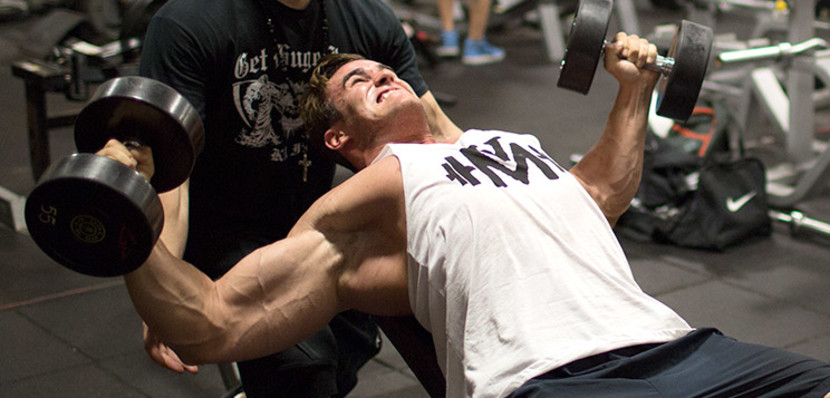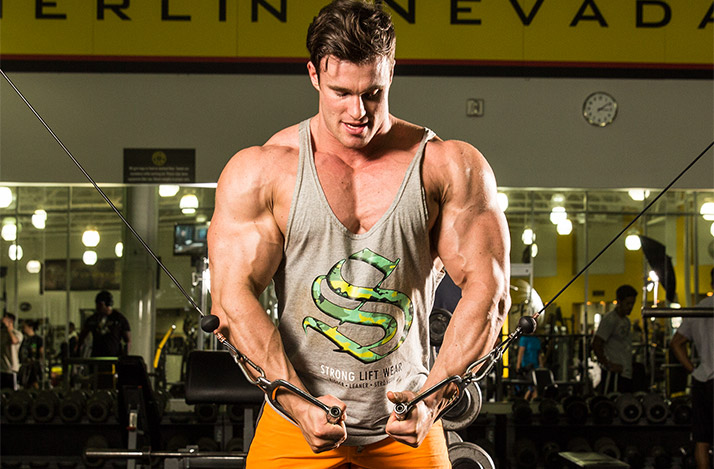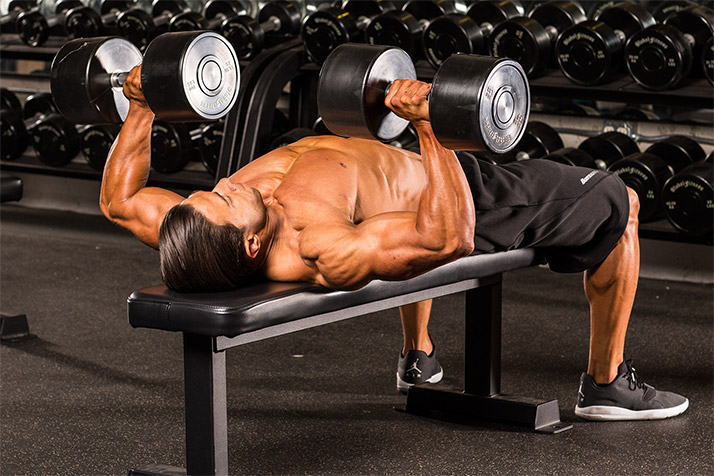What will you do if you find that your chest workout stops functioning? Let’s take a look at the following chest training tips for the best solution.

Making use of dumbbells
There are a lot of ways to differentiate your training while keeping you growing. And one of them is using dumbbells. This method allows you to deal with not only each side but also your pecs throughout a wide range of motion. It is also an ideal solution to your long shoulder workout.
One more way, you can sometimes conduct flat benches in the next session of your workout, which claims a better energy levels and the ability to lift more weight, regardless of what you have done in the first session. It is estimated that you can push your incline presses with 25 pounds, rather than the normal weight of 225 pounds, if you include this session. It is especially recommended to those who have upper-pec fibers which have worked at low intense levels for a long time.
Remember that once you include flat benches in your workout, your strength levels will tend to be compromised. Do not hope to gain both weight improvement and reps at the same time. You can deal with issues of weight with training equipment, so you will not have to balance the weight.
Varying your bench angles
It seems that lifters don’t paying much attention to inclining flat when it comes to benches on chest day. Actually, the rules of diminishing return can happen to the incline and decline benches, similar to the flat one. The difference lies in the way they work only.
Let’s check the adjustable bench and adjustable decline one. Both of them can be used with either dumbbells or Smith-machine training. And you can make adjustment for your preferred bench position.
For instance, you can vary your incline among a low position, a moderate one, or very steep. Each adjustment makes certain effects on the way the chest musculature is recruited. Similarly, you can change the way the declines are performed by shifting the bench.
For the best chest growth possible, do not pay attention to just these three angles of bench, try to explore a wide range of angles in between for real muscular development.
Do not press your flyers
Single-joint movements such as flyes and cable cross-overs are generally performed at the end of the workout. As you perform these moves, adjust your elbows to stay still in a slightly bent position. Consequence, you can’t use as much weight as you can with presses.
Maybe due to the the misunderstanding that the more pushed weight while doing single-joint moves, the better, some exercises mistakenly lift too much weight compared to the reasonably handle, causing their form to break down. Actually, that too much weight doesn’t put you at risk of injury, the semi-press or fly movement will decrease the isolation degree.
Cable cross-overs can be an example of such fly movement. First, check the bend degree in your elbows after experiencing the range of motion. Then, set a slight bend in your elbows and keep it during the session. After that, you will find your elbows closing up, it is the time when you’re pressing the weight, finally, open toward the top.
Actually, it doesn’t matter to do presses, but cables aren’t ideal to do this since your body isn’t stabilized enough to against a bench where a strong push is done. So let’s put your weight to thing which allows you to maintain your form during the set, also, remember to keep a close eyes to your elbows!
In case that you have difficulties locking the slight bend in your elbows when doing flying or cross-overs, make use of the pec-deck machine, it is good at keeping your arms in position.

Reinforce your strength at front-delt
If you’re planning to improve your pecs, then the ideal place to check is your delts, specifically the front heads. The reason is that they are active as you do pressing on the chest, especially when you make incline movements. In case it is not strong for the chain, they will hold back your chest gains.
This place is somewhat related to your shoulder workout. Let’s think over doing overhead shoulder presses which are more front-delt oriented. Two good examples for this are barbell presses and Arnold presses as they require you to take the bar in front of your head. Plus, the place where the single-joint front-delt moves first during your rotation of single-joint moves, can be work fine.
Be sure about strong triceps
Along with front delts, triceps are also ideal to hold your chest gains back. They do not simply support the ride, they play function of a primary mover also. This means that they’re weak compared to other factors, every other parts of the bench press is going to get affected.
The Rx is a simple and easy arm work for low-to-moderate reps. You will probably even have to double up your triceps as you work over split course. The note is that do not perform arm work the day before chest training.

Do not forget your back side
Yeah, you may be feeling unreasonably to mention to back training while talking about chest-training. But it is true that back training makes effects. If your chest makes improvement but your back lags, this difference will influence your posture and pull your shoulders forward as well, resulting in a slouched appearance. So be serious to make balance for parts in your physique. (Balance means covering every major muscle group, even that which is invisible in the mirror.
Making enough pressing as you up and down
Forgetting any range of motion as moving will badly affect your growth. If you’re always neglecting the bottom part of the rep, it will certainly get no strength built. So it is recommended to performing partial-rep training as an adjunct before it comes to full-range training, but do not neglect it, especially when you want to train for maximum muscle size.
Withdrawing your shoulder blade
Generally, we rarely think of what our shoulder blades are doing as you having chest training. And you feel comfortable to lower the bar to your chest and then press it back up. But this action is like that you’re simply lowering your arms behind the plane of your chest. Alternatively, you can withdraw your shoulder blades once you finish the negative rep, which will help to swell your chest out like a barrel. This proper stretch allows you to better produce force through your pecs while steadying and protecting your shoulders.
Varying your grip on barbell benches
Rather than take a standard grip on a barbell, why don’t you reposition your hands, slightly starting with very close position to very wide on. As your hands slightly close together, your inner pecs will work a better degree, the range of motion will be at the longest, and your triceps will take part in the play seriously. In contrast, pushing your hands way out will change the target to the outer portion of the pecs and shoulders and the the range of motion is highly limited.
Keep in mind that what I’ve mentioned is not the only position, there are various hand positions that you can apply. And each of them involves musculature in a different way. So let’s make occasional changes between working with a slightly closer and wider grip on the bar, then you will be able to better boost your overall chest development.
They are 9 proven chest training tips that have been bringing results to hundreds of users who have checked it, and you yourself can be one of them, why not? Let’s learn and follow the guides, then everything will be possible.

Diana Paul is a certified nutritionist who writes for leading health blogs. She is a master herbalist, yoga teacher, forager, and wild-crafting writer She is focused on helping people transform life blocks to opportunities. Based in NYC, she often holds health seminars and lectures.
